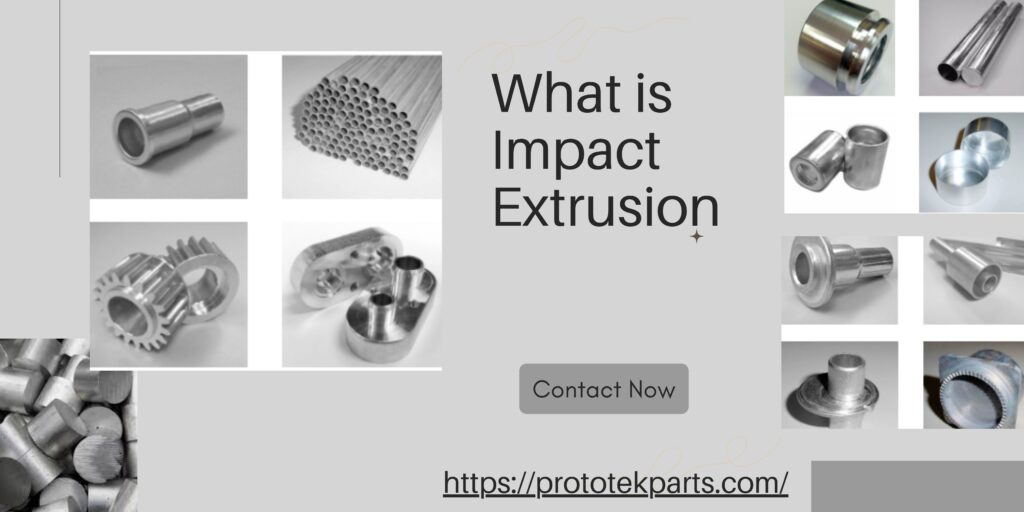What is Impact Extrusion

What is Impact Extrusion Impact Extrusion is a metal processing technology that places a metal blank in a die. Under high-speed impact or pressure, the metal blank undergoes plastic deformation inside the die, ultimately forming the desired product shape. What is extrusion Extrusion is a metal-forming process typically used to create linear products with a fixed cross-sectional profile. It is accomplished by forcing metal (or other material) through a die with the desired solid or hollow cross-section. There are several benefits to extrusion. First, many shapes can be made through extrusion, often with very complex designs. It can also be used on otherwise brittle metals since the stresses involved are only compression and shear. The finished parts also tend to have an excellent surface finish. While impact extrusion is one method, there are a variety of extrusion options available to manufacturers. These include the standard hot and cold extrusion processes as well as friction extrusion. Another similar process is drawing, the only difference being that the metal is pulled through a die rather than pushed through it. What is the impact extrusion process? What distinguishes impact extrusion from other processes is that the workpiece is forced through an aperture at a much higher speed than other methods. The first step in the impact extrusion process is to take a block of metal and place it into a press. The press may be mechanical or hydraulic and can cycle up to 60 times per minute. The punch then pushes the block into the die at great speed, forcing the block’s metal to reshape around the punch while conforming to the outside of the die. This action controls the final shape of the workpiece, both inside and outside. Lubricants can be added as needed to facilitate this process. One strike is enough to form the block into its new shape, and then a reverse strike is used to eject the metal from the die. There are three types of impact extrusion operations. A forward strike is where the block is pushed into the die. A reverse strike forces the block around the punch. A combined strike is where the block is pushed into the die and around the punch simultaneously. It is important to note that the thickness of the workpiece is directly related to the gap between the punch and the die. This means that the thinner the workpiece, the tighter the tolerances. Also, as mentioned earlier, the surface finish of the finished piece will be better than the starting piece. The aluminum’s grain structure is refined during this work-hardening process, strengthening the metal in its new form. Metal extrusion can be subdivided into the following categories based on the direction of the extrusion flow and the medium through which the force is applied. Metal extrusion types Direct extrusion Indirect extrusion Hydrostatic extrusion Transverse or longitudinal extrusion Impact extrusion They can also be classified based on the operating temperature Hot extrusion Cold extrusion What are the advantages of impact extrusion? Impact extrusion is becoming increasingly popular, especially when processing aluminum alloys. As already noted, since it is a cold working technique, preheating the workpiece is unnecessary, saving time and money while gaining the benefits of cold working. This method is favored not only for its efficiency but also because it allows the metal to be deformed at or near room temperature. The process leverages the superior power of the press machine, which is capable of shaping the metal without the need for additional heating. This eliminates the steps associated with heating, streamlining production and enhancing energy efficiency. By avoiding preheating, manufacturing companies can reduce their energy costs while maintaining the integrity of the material. This makes impact extrusion an attractive choice for industries aiming for both performance and sustainability. It is also faster because only one impact is required. The power of the punch mechanism is only required for one impact. Tooling costs tend to be lower, while the tooling itself lasts longer than other techniques. In terms of efficiency, the impact extrusion process has a high yield with minimal wasted material. Impact extrusion offers other advantages over other methods, including increased corrosion resistance, uniform grain alignment, and a lighter finished product. Additionally, the finished product requires little to no machining after processing. Which aluminum alloys are associated with impact extrusion? All aluminum alloys are well-suited for impact extrusion. Some of the advantages of aluminum alloys that make impact extrusion an excellent choice include its much lower density compared to steel, copper, nickel, and other metals. Aluminum is also non-toxic when it comes to food storage, and extrusion is widely used to produce food containers, such as beverages and food cans. Most of the aluminum alloys used in this process are in the 1000 series and 6000 series. What are some common impact extrusion applications? It is important to know that impact extrusions have certain limitations in terms of geometry. The finished product size needs to have a symmetrical cross-section, whether round, square, or oval; the base of the part must also be thicker than the sidewalls due to the nature of material flow in the process. Impact extrusions have a variety of uses. Common uses include pump components, pressure vessels, drive components, air conditioning components, fuel tank connectors, food and beverage cans, various cartridges, and tubes. If you have any needs, contact us via email at Lynnyao@prototekparts.com or phone: +86-0792-86372550 Tags: Social Network: Recently Posts Online Help! +(86) 0791-86372550 Have Questions? Want To Discuss In Detail? Contact Our Consultant Now CONTACT



